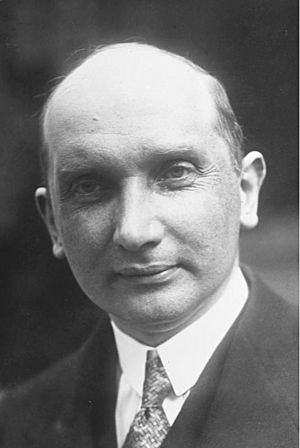August Zaleski facts for kids
Quick facts for kids
August Zaleski
|
|
|---|---|

Zaleski in 1931
|
|
| President of Poland President of Poland-in-exile |
|
| In office 9 June 1947 – 7 April 1972 |
|
| Prime Minister | Tadeusz Bór-Komorowski Tadeusz Tomaszewski Roman Odzierzyński Jerzy Hryniewski Stanisław Cat-Mackiewicz Hugon Hanke Antoni Pająk Aleksander Zawisza Zygmunt Muchniewski |
| Preceded by | Władysław Raczkiewicz |
| Succeeded by | Stanisław Ostrowski |
| Personal details | |
| Born | 13 September 1883 Warsaw, Congress Poland, Russian Empire |
| Died | 7 April 1972 (aged 88) London, England |
| Political party | Independent |
August Zaleski (born September 13, 1883 – died April 7, 1972) was an important Polish figure. He was an economist, a politician, and a diplomat. He served twice as Poland's Minister of Foreign Affairs. Later, he became the President of Poland for the Polish government-in-exile. This government continued to represent Poland from outside the country during and after World War II, when Poland was under foreign control.
Contents
A Life of Service
August Zaleski was born in Warsaw, Poland, in 1883. After finishing school in Warsaw, he moved to London. There, he studied at the London School of Economics and earned a master's degree. During World War I, he could not return to Poland. So, he started teaching Polish in London. He also became involved with the Polish National Committee. This group worked to represent Poland to the Triple Entente, a powerful alliance of countries. Zaleski helped explain Poland's goals to English politicians.
Diplomat and Minister
When Poland became independent again in 1918, Zaleski became a skilled diplomat. He worked in Polish embassies in different countries like Switzerland, Greece, and Italy. He also represented Poland at the League of Nations. This was an international organization that aimed to keep peace in the world.
After a political event in Poland called the May Coup d'État in 1926, Zaleski joined the side of Marshal Józef Piłsudski. From 1926 to 1932, he served as the minister of foreign affairs in two different Polish governments.
The Danzig Crisis
In 1932, while Zaleski was at a meeting of the League of Nations, a problem arose in Danzig (now Gdańsk, Poland). A Polish warship, the ORP Wicher, entered Danzig's harbor without permission. This caused a tense situation. Even though Zaleski hadn't known about the ship's visit beforehand, he strongly defended Poland's actions at the League of Nations.
He worked with the League's Secretary-General to find a peaceful solution. Zaleski offered that Poland would not send the Wicher back if the League helped resolve an issue about Poland's right to use Danzig harbor. His efforts were successful, and the problem was settled in a way that was good for Poland. This avoided a potential conflict.
Later Career and Exile
From 1928 to 1935, Zaleski was a member of the Polish Senate. After his term ended, he left politics for a while. He became the chairman of Bank Handlowy, a well-known Polish bank. He held this position until 1939, when Germany invaded Poland, starting World War II. Zaleski managed to move the bank's money and assets safely, first to France and then to the United Kingdom.
While in exile (living outside Poland), August Zaleski again became the minister of foreign affairs. This time, he served in the government led by General Władysław Sikorski.
In June 1947, Zaleski was chosen to be the president of the Polish government in exile. This government continued to act as Poland's official government from London, as Poland itself was under communist control. At first, many Poles living outside Poland supported him. However, by the end of his seven-year term, some political leaders disagreed with him. Zaleski decided to stay on as president for longer than planned. This led to a disagreement, and some Polish leaders in exile formed a group called the Council of Three. For nearly twenty years, both Zaleski and the Council claimed to be the rightful leaders of the Polish government in exile.
Death and Legacy
August Zaleski passed away in London on April 7, 1972. After his death, two different documents were found naming his successor. The Council of Three accepted Stanisław Ostrowski as the next president, and the Council then ended its work. In November 2022, Zaleski's remains, along with those of two other former presidents in exile, were moved from England to a special mausoleum in Warsaw, Poland.
Zaleski's important papers about his diplomatic work and Polish life during and after World War II are kept at the Hoover Institution.
See also
 In Spanish: August Zaleski para niños
In Spanish: August Zaleski para niños

